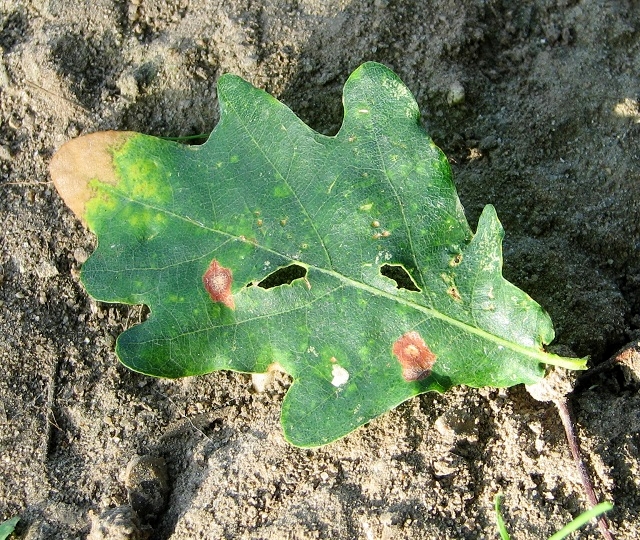Introduction
Oak leaf gall mite (Pyemotes herfsi), also known as itch mite, is an ectoparasitic insect in the genus Pyemotes. It is a secondary invader of oak trees that parasitizes numerous insects. Oak leaf gall mite was first identified in Central Europe in 1936. It is notable for its reproductive capabilities. Each female can carry up to 250 offspring at a time. When mature, the females enter galls that have formed on oak trees, and parasitize the larvae contained within.
Once the females have given birth, the mites drop from the gall, and are dispersed by air currents to surrounding locations. During this period, the mites often inadvertantly make contact with humans. When the mites land on or near a human, they will attempt to feed on them. If a human has been bitten by an oak leaf gall mite, the affected skin will develop a red patch, with a small bump arising in the center. While the irritation caused by the mites is typically minor, a few hospitalizations have been reported.
Distribution & Habitat
The range of oak leaf gall mite extends across Europe, northern India, northern Africa, Chile, Australia, and the United States.
Hosts
Oak leaf gall mite infests red oaks. It is most partial to pin oak. The insect tends to feed on oak midge larvae, but it also parasitizes Anobium punctatum, the Asiatic honey bee, Grapholita molesta, periodic cicadas, the pink bollworm, Tineola bisselliella, and various pests of stored grains. Oak leaf gall mite will also attempt to feed on humans and animals.
Description
Oak leaf gall mite is tiny, measuring up to 0.2 mm in length, when mature. The insect has an elongated body, with a shiny exoskeleton that is reddish-tan to white in color. It features four pairs of legs, two of which are located at the anterior, and two that extend from the posterior. When pregnant, the abdomen of the females bulges, causing them to appear larger.
Life Cycle
In spring, the adult males emerge from the abdomens of the females. The males mate with the females, expiring shortly thereafter. Upon being fertilized, the females navigate to nearby oak galls. They penetrate into the galls through small openings located at the ends of the folded margin of the gall. Once the females become situated, they target the gall larvae developing within the gall. The females inject a nuerotoxin into the larvae, effectively paralyzing them. Despite the small stature of the oak leaf gall mite, the nuerotoxin it produces is so potent, it can subdue insects that are considerably larger in size.
As the gall larvae are nuetralized, the females begin feeding on them. Their feeding continues until their offspring are born. The life cycle of an oak leaf gall mite may be completed in a week. This enables the insect to proliferate rapidly. Cooler, moist conditions are most favorable for development. As such, populations tend to become most dense from late summer to early winter, when cooler temperatures prevail. As the mites are born, they vacate the galls, and are disseminated by the wind to new areas. This type of dispersal is often referred to as a mite shower. When temperatures plummet in winter, the females overwinter in the galls, on leaves, or in leaf litter, and resume activity the following spring.
Symptoms of Infestation
The galls associated with oak leaf gall mite are tiny, extending up to 1/8 of an inch in width. The galls are induced by a gall midge, a type of fly that infests a bevy of trees. Oaks are especially susceptible. The galls are initially green. At first, they are inconspicuous, blending in with the plant’s foliage. They become more visible in fall, once they have hardened, and turned brown. Oak trees that exhibit foliar discoloration, with leaves that are distorted or crusty, may be infested. Galls that are plucked from infested trees and opened will reveal the mature females.
Allergenic Potential
When dispersed, the mites will attempt to feed on any living creature they land on. This makes them especially problematic for humans. If a mite bites the skin of a human, a small reddish patch will develop on the affected area, with a blister arising in the center. Bites generally take 10 to 14 days to subside. Humans are most frequently bitten on the torso, legs, arms, and back.
Management
- The incidence of biting can be reduced by concealing vulnerable parts of the body when around infested trees.
- Insect repellents can be applied to clothing to reduce or eliminate the potential for bites, although the efficacy of insect repellents varies.
- After spending time outdoors in an infested area, place any clothing you have worn in a washing machine, and cleanse them with laundry detergent and hot water. This will eliminate any mites that have attached themselves to the fabric. Oak leaf gall mites can reside on clothing for several days if not tended to.
- Immerse yourself in hot water, and wash your body thoroughly with a washcloth and soap. The soap will immediately kill any mites that are present on your body. Shampoo and rinse your hair to prevent the mites from biting your scalp.
- Ensure that windows and doors are sealed shut to deter the mites from traveling indoors.
- Pesticides are not recommended for use in controlling oak leaf gall mite. The mites dwell within the oak galls, which protect them from spray applications.
- Soothe bites with organic anti-itch creams. Refrain from scratching bites, as this can result in further inflammation.
Additional Resources
http://ento.psu.edu/extension/factsheets/leaf-gall-itch-mite
https://www.cdc.gov/mmwr/preview/mmwrhtml/mm5438a3.htm
Photo courtesy of Evelyn Simak CC-by-2.0


